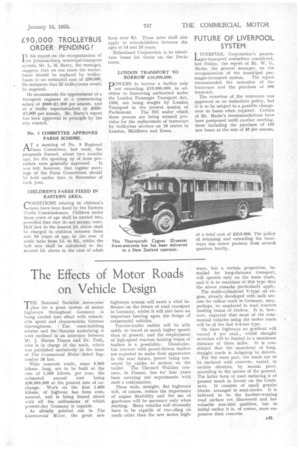The Effects of Motor Roads on Vehicle Design
Page 55

If you've noticed an error in this article please click here to report it so we can fix it.
THE National Socialist seven-year plan for a great system of motor highways throughout Germany is being carried into effect with remarkable speed and characteristic German thoroughness. I The road-building scheme and the theories underlying it were outlined in an interview between Mr. J. Harms Tiepen and Dr. Todt, who is in charge of the work, which was published exclusively in the issue of The Commercial Motor dated September 28 last.
Wide concrete roads, some 6,900 kiloms. long, are to be built at the rate of 1,000 kiloms. per year, the estimated annual cost being £36,000,000 at the present rate of exchange. Work on the first 1,600 kilorns, of highway has been commenced, and is being forced ahead with all the enthusiasm of which present-day Germany is capable.
As already pointed out in The Commercial Motor, the great new
highways system will exert a vital influence on the future of road transport in Germany, whilst it will also have an important bearing upon the design of commercial vehicles.
Tractor-trailer outfits will be able safely to travel at much higher speeds than at present, and the employment of high-speed tractors hauling trains of trailers is a possibility. Diesel-electric tractors with power-driven trailers are expected to make their appearance in the near future, -power being conveyed by cables to motors on the trailer. Trhe Chenard Walcker concern, in France, has for" four years been carrying out experiments with such a combination.
These wide, straight, flat highways will, of course, reduce the importance of engine flexibility and the use of gearboxes will be necessary only when starting. Many vehicles will obviously have to be capable of travelling on roads other than the new motor high
ways, but a certain proportion, intended for long-distance transport, will operate only on the main roads, and it is to machines of this type that the above remarks particularly apply.
The multi-cylindered V-type oil engine, already developed with such success for railcar work in Germany, may, perhaps, be employed in road tractors hauling trains of trailers. It is, however, expected that most of the commercial vehicles using the motor roads will be of the fast 3-4-ton type.
On these highways no gradient will exceed 5 per cent., whilst straight stretches will be limited to a maximum distance of three miles, It is considered that the monotony of long, straight roads is fatiguing to drivers.
For the most part, the roads are to be surfaced with concrete, varied, in certain districts, by mosaic pave, according to the nature of the ground. The latter form of road surfacing is at present much in favour on the Continent. It consists of small granite blocks, arranged in semi-circles. It is believed to be the hardest-wearing road surface yet discovered and has valuable non-skid qualities, but in initial outlay it is, of course, more expensive than concrete.




























































































